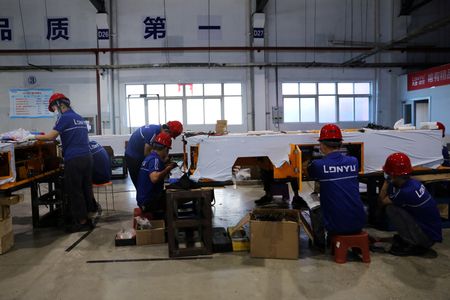By Joe Cash
BEIJING (Reuters) – China’s $18.6 trillion economy has skirted some near-term downside risks as suggested by recent indicators, analysts said, buying officials more time to convince investors they can fire up a new growth engine for 2024 and the years ahead.
Economic data over the January-February period and a factory owners survey for March offered relief to Chinese policymakers seeking to convince foreign investors they could rekindle the world’s No.2 economy after it failed to post a sustainable recovery following Beijing abandoning strict COVID curbs in late 2022.
But analysts and investors are cautious: while things might not be getting worse, unless officials can figure out how to get it to fire on all cylinders again, the market once seen as the engine of global growth will stall later in the year.
China has taken a series of steps to invigorate its economy,
including guiding banks to lend more to high-end manufacturing
rather than real estate and reducing the amount banks must hold in reserve, but such policy measures are becoming less effective and could even be scaled back, they said.
“China is pushing to have a normal 2024. They know they can still export, and they know that if they push this year, they can buy themselves time,” said Alicia Garcia Herrero, chief economist for the Asia Pacific at Natixis, .
“But China cannot grow more than last year, and it never will, as the fiscal cost of growing more than it did in 2023 is so huge,” she added. “China’s growth model is not sustainable.”
China’s factory output and retail sales topped forecasts in January-February, joining better-than-expected exports and consumer inflation indicators, providing an early boost to Beijing’s hopes of reaching what analysts have described as an ambitious 5.0% gross domestic product growth target for 2024.
Citi on Thursday raised its economic growth forecast for China for this year to 5.0% from 4.6%, citing “recent positive data and policy delivery”.
But China “faces a fork in the road” and needs to “reinvent itself for a new era of high-quality growth,” International Monetary Fund Managing Director Kristalina Georgieva told an international investment summit in Beijing last week.
The IMF in January revised its forecast up 0.4 percentage points to 4.6%, citing increased government spending, which remains short of last year’s actual 5.2% expansion.
Officials are putting their faith in “New Productive Forces”, a term coined by Chinese President Xi Jinping in September underscoring the need for economic development based on innovation in advanced sectors.
Still, analysts question whether China can maintain growth and transform its economy at the same time.
“China is barely keeping up with a growth rate that is decelerating, so (the data) is not ‘green shoots’,” Garcia Herrero said.
“5.2% is not the bottom, it’s the top,” she added.
Rhodium Group estimates actual growth in 2023 was more like 1.5%, rather than the official government figure, owing to an ailing property market, limited consumer spending, falling trade surplus and battered local government finances.
“Looking ahead, China may see a cyclical recovery to perhaps 3.0-3.5% growth in 2024,” the New York-based research group known for its China coverage predicted in December.
PROPERTY QUANDARY
Officials are confident China will hit its growth target of around 5% this year.
But investors want more details on the government’s plans to limit the damage a long-running debt crisis in the property sector is exacting on growth and how Beijing will boost domestic consumption to keep Washington and Brussels at bay, both of which are weighing up action against Chinese exports.
“China is off the map. And that’s something that they’ve barely started to grapple with,” said Rogier Creemers, an assistant professor of Chinese studies at Leiden University.
Analysts warn officials are running out of time to come up with a new growth model because the latest bounce in the data was buoyed by the government injecting money into the economy and the Lunar New Year, which fell in February this year, giving consumer prices and retail sales data a leg-up.
“Given the near-term tailwinds from stimulus, growth should continue to do reasonably well in the near term,” wrote Zichun Huang, China Economist at Capital Economics, in a note. “But once policy support is scaled back, probably later this year, structural headwinds mean the economy is likely to slow again.”
China’s property sector, which used to represent 25% of the economy, looms particularly large.
Property investment and sales fell more slowly over the first two months of the year, supported by government efforts to arrest a protracted downturn in the sector, but analysts still worry it could prove to be the economy’s undoing.
“(Officials) are basically fire-fighting at the moment to ensure the economy doesn’t skid off the rails,” said Frederic Neumann, chief Asia economist at HSBC in Hong Kong.
“But there’s the longer-term question of what will drive growth in the future, once the property sector subsides.”
(Reporting by Joe Cash; Editing by Muralikumar Anantharaman)

